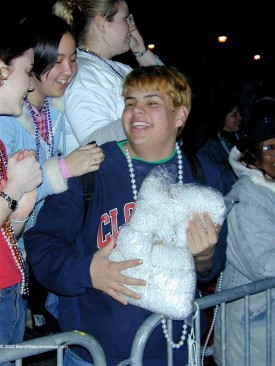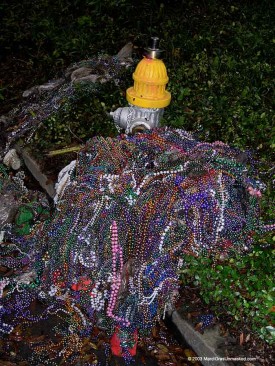In the heat of the moment, the perceived value of the exotic bounty tossed from parade floats cannot be measured in dollars and cents. Because it cannot be bought, only bestowed and won, it is, in a sense, priceless.
The quest for beaucoup booty at Mardi Gras
A windfall of pearls at the 2002 Knights of Hermes parade
The thrill and challenge of acquiring throws can bring ecstasy and fulfillment, however fleeting.
In New Orleans, the gaudiest things in life are free! And what an embarrassment of riches: showers of flashy spoils — known as “throws” — raining down from parade floats into the outstretched arms of whooping revelers consumed by a collective mania — a feeding frenzy that might seem dangerously maniacal if it wasn’t so darn entertaining.
On the floats, beads hang in huge bunches like shimmering, impossibly bountiful grape vines. The masked, satin-clad riders, surrounded by bags and boxes stacked like pirate booty, dangle and twirl sparkly strands of plastic pearls and show off cuddly collectibles — taunting and teasing the clamoring hordes.
Sometimes, in fits of irrational exuberance, they heave overboard full, unopened bags of loot — ratcheting up the pandemonium as even old folks and mild-mannered ladies in evening dresses push and grovel for a piece of the action.
Throws make Mardi Gras parades interactive, turning spectators into willful participants. The thrill and challenge of acquiring the baubles becomes a competitive sport, summoning both animal urges and creative strategizing in the form of clever signs, targets, nets, playful verbal come-ons — anything to get a rider’s attention.
In the heat of the moment, the perceived value of the exotic bounty cannot be measured in dollars and cents. Because it cannot be bought, only bestowed and won, it is, in a sense, priceless. Part of the fun comes from buying into this illusion, although it’s often said that the fantasy begins to fade almost as soon as the treasure is secure in one’s grasp; and indeed, some people will immediately give away the fruits of their begging to fellow parade-goers. For them, the thrill of the catch is everything.
For both rider and spectator, throws are ritual talismans that make possible an emotionally powerful experience — the fleeting sense of ecstasy and fulfillment that comes with establishing a mutually rewarding, one-on-one connection with a total stranger.
The average rider in a parade spends $600 to $800 just on throws, with some high rollers spending $2,500 or more. For a mega-parade like Endymion, with over 2,000 riders, that means upwards of $1.5 million of goodies tossed in a matter of hours.
For “throw mongers,” the “success” of a given parade has little if anything to do with such ephemeral criteria as the execution of a theme, the skill of the marching bands or the artistry of the floats. Rather, it’s all about the loot.
Unclaimed beads can pile up like so much junk
As one-upmanship among kewes has increased demand for fancier, more collectible throws, Mardi Gras beggars have become choosers.
The level of enjoyment is, quite simply, a function of the volume and quality of throws hauled in. Like big-game hunters, these folks are looking to bag trophies to show off to friends and family. Booty bestows bragging rights.
After the hunting season is over, while some of the more treasured throws may find a place as decorative mementos around the home, the bulk of the jewels invariably lose their allure and wind up cluttering closets and attics like so much useless junk. Hence the old joke about the weight of accumulated beads explaining the problem of subsidence, as New Orleans sinks ever further below sea level.
The ubiquity of beads during Mardi Gras does give rise to a certain jadedness. Piles of less desirable strands get left in the street to be gobbled up by mechanized sweepers, making the throw spectacle seem all the more garish and excessive.
For krewe members, however, throws have become a matter of pride. No longer is it sufficient simply to procure massive quantities of generic throws such as unadorned metallic beads, for Mardi Gras beggars have become choosers. Whereas years ago parade-goers would gleefully scramble for even the most modest trinket, nowadays they’ll seek out, and even ask for, specific specialty items and let the cheap stuff fall to the ground.
To the chagrin of some traditionalists who prefer to focus on the aesthetics of a parade, a krewe’s popularity is now determined to a significant degree not just by how much is thrown, but also by the uniqueness and collectibility of the items proffered. Untold hours are spent on the design, preparation and procurement of throws, and local importers vie to come up with the next hot tchotchke that can be customized and sold in bulk to krewes.
Indeed, throws have become a branding exercise as krewes work with suppliers to devise creative ways of transforming mascots, insignias and signature totems into prized collectibles. Every year, the local media loves to survey the newest and hottest offerings, helping fuel the competition among krewes to outdo one another and build brand loyalty among discerning connoisseurs.
Also stoking the trend toward custom creations: the infamous Mardi Gras barter economy on Bourbon Street, where necklaces with fancy krewe-logoed ornamentation are highly prized. And judging by the robust market for krewe memorabilia on eBay, certain throws continue to cast a glow long after the last float of the parade season has passed.
MardiGrasTraditions.com


